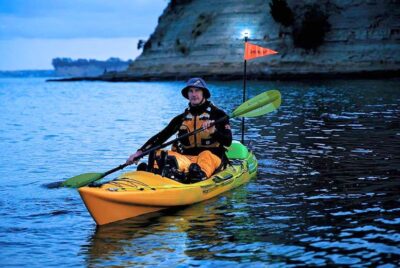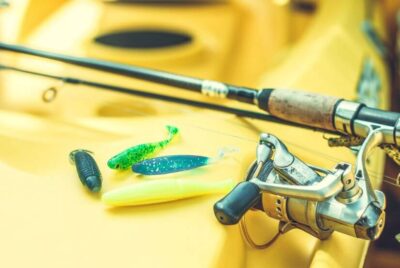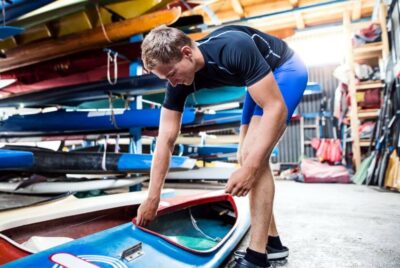Choosing the Best Kayak Cooler: Types, Tips, and Must-Haves
Are you searching for the perfect way to keep your drinks cold and your catch fresh during your water adventures? Look no further, a kayak cooler is the solution you’ve been seeking. This guide is your one-stop resource for choosing and utilizing the ideal kayak cooler for your needs. From types and features to packing tips, we’re covering it all. So, sit tight and let’s dive into the world of kayak coolers.
Why Do You Need a Kayak Cooler?
A kayak cooler is more than just a box to stash your drinks and sandwiches. It’s a highly engineered piece of equipment optimized for life on the water, especially in the confined spaces of a kayak.
Ever wondered why a kayak cooler is a must-have? While you might be tempted to use just any cooler, let me tell you, a kayak-specific cooler offers some serious perks. Here’s why you need one:
Key Benefits of Having a Kayak Cooler:
- Temperature Control: Keeps your food and beverages refreshingly cold, even on the hottest days.
- Fresh Catch Storage: Perfect for anglers, as it ensures that your freshly caught fish stays fresh until you’re back on land.
- Convenience: Designed to fit snugly within your kayak, maximizing space for other essentials.
- Durability: Built to withstand the harsh conditions of water sports, from splashing water to direct sunlight.
- Portability: Easier to carry and maneuver than traditional bulky coolers, some even come with shoulder straps for easy transport.

Types of Kayak Coolers
Alright, here are the types of kayak coolers you can choose from. Yes, there’s more than one! Each type comes with its own set of advantages and disadvantages. Understanding these can help you make an informed decision that suits your kayaking style and needs.
Hard-Shell Coolers
A hard-shell kayak cooler is what you might call the “rock” of kayak coolers. It’s solid, robust, and built to last. Made from materials like heavy-duty plastic and sometimes even metal, hard-shell coolers are well-insulated and can keep ice frozen for extended periods. They often come with sturdy handles and latches to ensure your goodies stay secure even in choppy waters
Ideal For: Extended kayaking trips, heavy-duty use, and when you need top-notch insulation.
Pros:
- Durability: These are the rhinos of the cooler world. They’re tough, built to last, and can withstand a lot of abuse.
- Insulation: Hard-shell coolers usually offer superior insulation, meaning they can keep your items cold for a longer time.
Cons:
- Weight: They are typically heavier than their soft-shell counterparts.
- Size: Due to their rigid structure, they might take up more space than you’d like in your kayak.

Soft-Shell Coolers
Soft-shell coolers are the “yogis” of the cooler world—flexible, convenient, and perfect for less demanding situations. Generally made from high-grade fabric materials like nylon or polyester, these coolers use foam-based insulation to keep your items cool. They can easily be squeezed into tight spots and are much lighter than hard-shell options, making them easier to transport.
Ideal For: Day trips, casual kayaking, and when portability and ease of use are high priorities.
Pros:
- Flexibility: These can fit into tighter spaces because of their soft exterior.
- Lightweight: They are generally lighter, making them easier to carry and maneuver.
Cons:
- Less Durable: Generally, they aren’t as robust as hard-shell coolers.
- Insulation: While decent, the insulation often doesn’t compare to that of hard shells.

Electric Coolers
The “tech geeks” of kayak coolers, electric coolers offer the convenience of your home refrigerator but on a smaller, portable scale. These coolers run on electricity and can maintain a consistent temperature for as long as they have a power source. They come equipped with plugs that can be connected to a portable battery or sometimes even your kayak’s electrical system if it has one.
Ideal For: Those who want the convenience of a fridge, have access to a power source, and are willing to invest in a pricier, high-tech option.
Pros:
- Consistent Temperature: These coolers maintain a constant temperature, ensuring your items stay equally cold.
- No Ice Required: Say goodbye to the hassle of filling your cooler with ice.
Cons:
- Power Source: You’ll need an external power source, like a battery pack, which can be cumbersome.
- Price: Generally more expensive than traditional coolers.
Factors to Consider When Buying a Kayak Cooler
So you’re revved up and ready to snag your own kayak cooler, huh? Hold your horses! Before you dive into the ocean of choices, there are some key factors to consider. From size to material to portability, let’s unpack what you should keep an eye out for.
Size and Capacity
Size is a critical factor, both in terms of the cooler’s physical dimensions and its internal capacity. Cooler sizes can range from small, personal-sized coolers of about 10 quarts up to large, multi-day coolers that can hold up to 65 quarts or more.
Quick Size Guide:
- Small (10-20 quarts): Ideal for half-day trips, can hold around 12-24 cans plus ice.
- Medium (21-40 quarts): Great for full-day trips or overnight adventures, can hold around 24-48 cans plus ice.
- Large (41-65 quarts): Best for multi-day trips, can hold up to 48-96 cans plus ice.
Measuring Cooler Size
Before hitting that “buy” button, arm yourself with a tape measure. Measure the length, width, and height of the space where you plan to put the cooler on your kayak.
Example Measurements:
- Small Cooler: Typically around 15” L x 10” W x 10” H
- Medium Cooler: Roughly about 20” L x 15” W x 15” H
- Large Cooler: Usually at least 25” L x 18” W x 18” H
Remember, when considering size, also account for the kayak’s weight capacity. You don’t want to exceed it once the cooler is filled. For instance, if your kayak has a weight limit of 400 pounds and you weigh 200 pounds, you’ll want to ensure your gear, including the cooler and its contents, doesn’t exceed 200 pounds.
Material
The cooler’s material plays a massive role not just in its durability but also in its ability to keep things, well, cool.
Durability and Insulation
For hard-shell coolers, think about materials like heavy-duty plastic or even metal. These materials tend to offer better insulation and will likely last longer. Soft-shell coolers often use high-grade fabrics, which are lighter but might not offer the same level of insulation.
Portability
Here’s where the rubber meets the road—or rather, where the cooler meets your back. You’ll likely have to carry the cooler from your car to your kayak and maybe over some rocky or sandy terrain.
- Handles and Straps: Look for coolers with sturdy handles or shoulder straps for easier carrying.
- Weight: Consider the cooler’s weight, especially if you’ll be hauling it significant distances. Soft-shell coolers generally win in the lightweight category.
- Ease of Access: Think about how easy it is to open and close the cooler while you’re out on the water. You don’t want to fight with a stubborn lid when you’re trying to snag a quick sip.

Where to Place Your Kayak Cooler
So you’ve picked out the perfect kayak cooler, but where should it go? Placement matters, my friends. The location of your cooler can affect your kayak’s stability, ease of access to your goodies, and overall paddling experience.
- Behind the Seat: This is a popular spot for sit-on-top kayaks. It’s accessible, and the cooler can often act as a backrest.
- Bow or Stern: For sit-inside kayaks, the bow or stern can be a good location. Just make sure it’s securely tied down to avoid it becoming a hazard.
- Center Compartment: Some kayaks come with a dedicated center compartment specifically designed for coolers or other gear. This is an excellent spot if you have it.
- Between Your Legs: For smaller, soft-shell coolers, you can place them between your legs for easy access.
Remember, always consider the weight distribution. A heavily loaded cooler can affect your kayak’s stability. Make sure to test your setup in shallow water before heading out into deeper waters.
How to Pack a Kayak Cooler
Alright, now that you know where to place it, let’s talk about packing this bad boy efficiently. Believe it or not, there’s an art to it.
- Pre-chill Items: Before you place them in the cooler, make sure your beverages and food are already chilled. This will help the ice last longer.
- Layering: Start with a layer of ice at the bottom, add your items, and then top it off with another layer of ice.
- Seal Food Items: Use airtight containers or zip-lock bags to keep food items from getting soggy.
- Use Ice Packs: For longer trips, ice packs can be more effective than loose ice. They last longer and take up less space.
- Keep Essentials on Top: Place items you’ll need frequent access to, like drinks and snacks, on top so you don’t have to dig through the cooler.
- Utilize Cooler Sections: Some coolers come with dividers or separate compartments. Use these to keep items organized.
- Waterproofing: Double-check that the cooler’s seal is working correctly to keep water out, especially if you’ll be kayaking in choppy waters or conditions where the cooler might get splashed a lot.

Tips for Keeping Your Kayak Cooler Cold Longer
So you’ve got your dream kayak cooler and you’ve packed it like a pro. Now, how do you make sure it stays icy-cold for the duration of your trip? From pre-chilling to using the right type of ice, let’s get into the nitty-gritty of keeping your cooler cold for as long as possible.
- Pre-Chill the Cooler: This is a simple but often overlooked step. Before you load up your cooler, fill it with ice or ice packs to lower its internal temperature. Doing this even just a few hours before packing can extend the life of your ice during the trip.
- Use the Right Ice: All ice is not created equal. Using larger blocks or reusable ice packs can help maintain cold temperatures for longer periods compared to standard ice cubes. Why? Larger ice masses have less surface area exposed to heat, meaning they melt more slowly.
- Pack Items in Reverse Order: Think about what you’ll need first and pack it last. This minimizes the amount of time you’ll spend rummaging through the cooler, letting cold air escape.
- Seal the Cooler Properly: Every time you open your cooler, cold air escapes and warm air gets in. Make sure to close and seal your cooler as soon as you’re done grabbing what you need.
- Avoid Direct Sunlight: Where you place your cooler matters. Try to keep it in the shade or under a tarp to avoid direct sunlight. The sun’s rays can quickly raise the internal temperature of your cooler.
- Limit Cooler Access: Every time you open the cooler, you’re giving the cold air a chance to escape. Try to limit how many times you access the cooler. Plan your meals and snacks so that you can grab multiple items at once.
- Use a Cooler Cover or Blanket: For those really hot days, consider using a cooler cover or a wet towel to add an extra layer of insulation. This can keep the cooler colder for a longer period.
Must-Have Accessories for Your Kayak Cooler
You’ve got the cooler, you’ve got the kayak, and you’re almost ready to hit the water. But wait, what about those extra bits that can make your cooler experience next-level awesome? These are the must-have accessories that can elevate your kayaking adventure from good to great.
- Tie-Down Straps: A good set of tie-down straps can secure your cooler to your kayak, ensuring it stays put even in choppy waters.
- External Pockets: Some coolers come with them, but if yours doesn’t, you can buy external cooler pockets. These attach to the outside of your cooler and provide extra storage for keys, snacks, or a fishing lure or two.
- Divider Inserts: Dividers can turn your one-compartment cooler into a multi-section storage solution. Perfect for separating drinks from food or keeping bait away from your sandwiches.
- Bottle Openers: You’d be surprised how many people forget to bring a bottle opener. Some high-end coolers come with one built-in, but if yours doesn’t, a portable one can be a game-changer.
- Slide-Resistant Mats: To keep the cooler from sliding around in the kayak.
- Cooler Lights: If you plan to do some early morning or late evening kayaking, having a light in your cooler can make finding what you need a breeze. These are typically waterproof and can be easily attached to the cooler’s interior or lid.
- Ice Packs: Reusable ice packs are not only more eco-friendly than using single-use plastic bags filled with ice but they also last longer. They can keep your items cold without making everything soggy.
- Cooler Caddy: If you’ve got a big cooler and a long way to go from the car to the water, a cooler caddy can save your back. It’s a small cart designed to hold your cooler, making it much easier to transport.
- Cooler Cover: A protective cover adds an extra layer of insulation and shields the cooler from direct sunlight, extending the time your contents stay cold.

Cleaning and Maintenance
It’s time to show your cooler some TLC. Proper cleaning and maintenance are essential for prolonging the life of your cooler and making sure it performs at its best on every adventure. Let’s get into it.
Regular Cleaning
This is basic but crucial. After each trip, make sure to:
- Empty Out: Remove all leftover items and discard any melted ice.
- Wash Down: Use a mild detergent and warm water to clean the interior and exterior. For those hard-to-reach corners, a toothbrush can be handy.
- Rinse: Rinse thoroughly with clean water to remove any soap residue.
- Air Dry: Leave the cooler open to air dry completely before storing it. This will prevent mold and mildew.
Deep Cleaning
Every once in a while, especially after longer trips, your cooler will benefit from a deep clean.
- Use a Cleaning Solution: Mix a cleaning solution of water and vinegar or baking soda. This will help get rid of any tough stains or odors.
- Scrub: Use a brush or sponge to scrub every inch of the cooler, inside and out.
- Sanitize: For a more thorough clean, you can use a bleach-based cleaner. Just make sure to rinse very well afterward.
Inspect and Repair
Every once in a while, especially after longer trips, your cooler will benefit from a deep clean.
- Use a Cleaning Solution: Mix a cleaning solution of water and vinegar or baking soda. This will help get rid of any tough stains or odors.
- Scrub: Use a brush or sponge to scrub every inch of the cooler, inside and out.
- Sanitize: For a more thorough clean, you can use a bleach-based cleaner. Just make sure to rinse very well afterward.
Conclusion
From the moment you consider buying a kayak cooler to the point where you’re maintaining it for years of future adventures, there’s a lot to consider. Picking the right type based on your needs, knowing what accessories can elevate your experience, and keeping your cooler in tip-top shape all contribute to a successful day out on the water. A well-chosen, well-maintained kayak cooler is more than just a box to hold ice—it’s your trusty companion in waterborne adventure, ensuring you have access to cold drinks, fresh food, and even serving as a seat or makeshift table in a pinch.
Remember, the key to longevity and optimal performance is regular cleaning and timely maintenance. And don’t forget, with the right tips and tricks, you can keep that cooler cold for an impressively long time.
So, are you ready to elevate your kayaking experience? With the right cooler and a bit of know-how, you’re all set for your next water adventure. Here’s to cold drinks, fresh snacks, and unforgettable kayaking trips!
FAQs
Q: Can I use regular ice packs instead of specially designed kayak cooler ice packs?
A: Yes, you can use regular ice packs, but keep in mind that ice packs designed for kayak coolers are generally more effective at maintaining low temperatures over extended periods. They may also be shaped to better fit the cooler’s dimensions, maximizing cooling efficiency.
Q: How often should I deep clean my kayak cooler?
A: The frequency of deep cleaning depends on how often you use your cooler and what you store in it. If you often carry perishable foods or raw fish, a deep clean after each use is advisable. For less demanding usage, a monthly deep clean should suffice.
Q: Is it safe to store electronics and other sensitive items in a kayak cooler?
A: While a kayak cooler is designed to be water-resistant and well-insulated, it’s not 100% waterproof or shockproof. If you need to carry electronics or other sensitive items, consider using a separate waterproof and shock-resistant case.
Q: Do all kayak coolers come with tie-down straps?
A: Not all kayak coolers come with tie-down straps. Some might have built-in features that allow for secure placement, while others may require you to purchase straps separately. Always check the cooler’s features and consider buying additional straps for added security.
Q: Can I use my kayak cooler for other outdoor activities like camping or hiking?
A: Absolutely! A high-quality kayak cooler is versatile and can be a great addition to any outdoor activity requiring food and drink storage. However, keep in mind the size and weight of the cooler if you plan to use it for hiking, as what is manageable on water might not be so on land.





